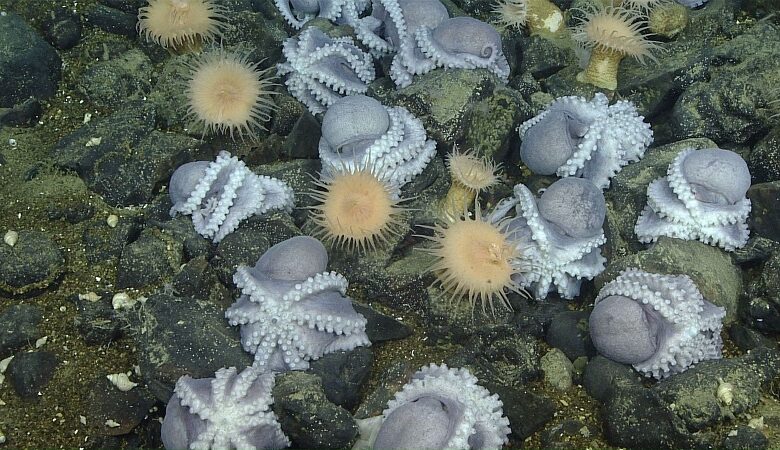The Enigmatic Octopus Garden: Deep-Sea Discoveries Unveil Nature’s Secrets

Five years ago, as scientists ventured into the depths of the ocean, their submarine’s headlights pierced the pitch-black abyss, revealing an astonishing sight—an assembly of 6,000 octopuses meticulously arranged in rows along jagged outcrops of sea rock, resembling glistening pearls. This extraordinary discovery, often referred to as an “octopus garden,” remains unparalleled in its scale, with experts considering it the largest congregation of pearl octopuses ever documented, according to marine ecologist Jim Berry from the Monterey Bay Aquarium Research Institute.
Remarkably, the team’s estimation suggests that the total population of octopuses in this underwater spectacle could exceed a staggering 20,000 individuals, making it a truly exceptional find in the depths of the ocean.
However, what baffled scientists more than the sheer numbers was the question of why these typically solitary creatures had gathered in such vast numbers at this location. Berry and his collaborators soon deduced that the octopuses were not only congregating but also breeding in this peculiar setting, a phenomenon that defied the typical behavior of deep-sea octopuses.
In the depths of the ocean, octopuses usually face formidable challenges in their efforts to reproduce. The frigid temperatures and harsh conditions result in the eggs of these cephalopods taking an astonishing four years to hatch, a grueling process that demands tremendous energy and endurance. In stark contrast, the octopuses inhabiting this particular nursery accelerated their reproductive cycle, with their eggs maturing in a mere two years.
The scientists posit that the presence of warmer waters in this region aids in expediting the egg maturation process, while the rocky walls provide a safe and stable environment for the cephalopods to store their eggs. These advantages significantly enhance the octopuses’ ability to reproduce more swiftly and efficiently than their counterparts in the cold and unforgiving depths.
Berry elucidated, “It’s really tough to make a living in the deep sea. And these octopuses have found a way to find thermal springs so that they can improve their reproductive success.” The newfound nursery offered the octopuses an unexpected opportunity to thrive and proliferate in an otherwise challenging environment.
The discovery of the octopus garden unfolded through fourteen dives conducted over five years by Berry and his team, utilizing an uncrewed submarine. During these explorations, they observed adult male and female octopuses, their eggs, and the lifeless bodies of the parents. A poignant detail about pearl octopuses is that they perish shortly after reproducing, a cruel twist of nature that attracts ocean scavengers to the area, where they feast upon the remains of the deceased parents. Thus, this underwater site emerges as a poignant nexus of life and death, where the circle of existence plays out against the backdrop of the ocean’s depths.
The octopuses’ choice of this unique location, the Davidson Seamount, carries its own intrigue. This underwater volcano, now extinct, rests approximately 10,500 feet below the ocean’s surface, located 80 miles southwest of Monterey, California. Astonishingly, prior to 2018, researchers were unaware of the presence of volcanic vents in this area, as Berry revealed. This revelation underscores the notion that humans have barely scratched the surface of ocean exploration, with UNESCO estimating that we have charted only around 5% of the vast oceanic expanse. Consequently, the prospect of undiscovered marvels, including ingenious communities of cephalopods, lurking in the uncharted depths of the sea looms large.
Berry emphasized the imperative of preserving our oceans, underscoring the need to safeguard their unique and delicate ecosystems before human impacts irrevocably alter these environments. He articulated, “As we explore more of the deep sea, we find more and more that it’s not just a homogeneous, deep, sort of mud-covered pit. There are special places that play a large role in either the geology or the biology or ecology of different areas.”
News Mania Desk / Agnibeena Ghosh 5th September 2023






